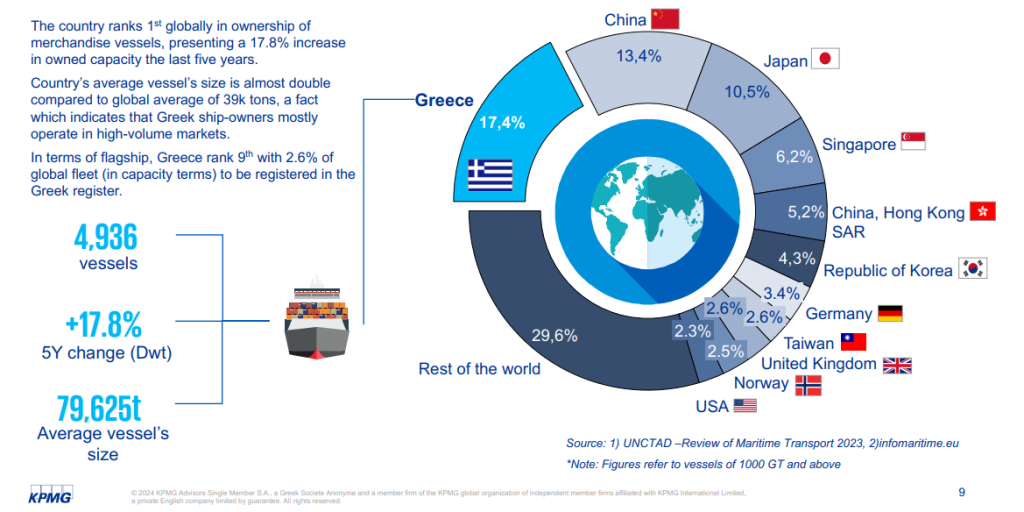KPMG presents a shipping market overview, as well as the trends and challenges, in an era where the maritime industry undergoes major changes.
Key industry trends
According to KPMG, the global shipping industry is expected to continue its ascending course, despite issues with accessibility, manpower, and the current ecopolitical turbulence. Ship owners and operators have suffered from shortages of vessel space and containers, while carriers had to consolidate port calls. On the other hand, ports have reported managing several logjams. Therefore, key players across the shipping industry are aiming for greater resilience while shipping economies will need to futureproof their ports and maritime supply chains. Other key facts, as presented by KPMG, are:
#1 Fleet
- The world fleet is dominated by small and medium-sized ships up to 25,000 GT (83%), while small ships alone represent 38% by number, although around only 1% by tonnage.
- None of the very large ships reached their 25th anniversary, reflecting the tendency to renew and grow large-sized fleets year by year.

#2 Supply – demand
- More container ships will facilitate the ship availability problem and are expected to lower freight rates.
- The increased number of vessels in operation will restore the supply-demand balance in the coming years.
#3 Accessibility
- The problem of vessel availability, amplified by port delays and changes in consumer priorities, will ease in the years to come.
- Infrastructure bottlenecks may occur from time to time, causing problems throughout the supply chain, spanning from port and ship capacity to the ability of logistics networks to deliver goods to their final destination.
#4 Ecopolitical turbulence
- The ongoing conflicts in Ukraine and the Middle East have significantly impacted the shipping industry.
- Key trade routes, particularly in the Black and Red Seas, are experiencing disruption due to increased military activity, maritime restrictions, attacks on US and European ships, and port closures.
- As a result, longer and more expensive routes are becoming necessary.
#5 Human resources
- The latest Seafarer Workforce Report from BIMCO and the International Chamber of Shipping (ICS) expects a significant shortage in maritime officers by 2026.
- Women seafarers make up only 2 percent of the crewing workforce and are mostly found in the cruise industry, while they make up 34 percent of the workforce in ship-owning corporations.
Key industry challenges challenges
As explained, the challenges mentioned below by KPMG possess transformative potential for the shipping and port industry.
#1 Environmental concerns
The maritime industry, handling around 90% of global goods transport, could cause 17% of human carbon emissions by 2050. To meet sustainability goals, stricter environmental regulations are being enforced, like the mandatory Energy Efficiency Existing Ship Index (EEXI) calculation from January 2023. The shift away from fossil fuels will accelerate oil rig decommissioning in favor of offshore wind farms, raising collision risks that necessitate improved marine navigation aids.
#2 Shortage of skilled talent
The maritime industry’s skills shortage is exacerbated by new technology adoption and a lack of young talent due to tough working conditions and long sea periods. COVID-19’s lasting effects on crew changes and the Ukraine crisis impacting tanker officers worsen the situation. With advanced technologies emerging, significant training is needed to meet safety standards. To attract talent, the industry should promote STEM education, environmental responsibility, and support schemes for women and underrepresented groups.
#3 Political unrests
Geopolitical tensions, like the war in Ukraine and Middle East, disrupt shipping routes and port operations, trapping vessels and altering supply chains, which spikes commodity prices and worsens crew shortages. The shipping industry also contends with growing environmental regulations, potentially incurring extra costs as it aims to cut carbon intensity by 70% by 2050.
#4 Rapid technological change
Embracing new technologies is key to the maritime industry’s efficiency and growth. AI will enhance route planning, aiding a 9.3% CAGR in autonomous shipping by 2030. Remote monitoring with sensor-equipped data buoys will increase shipping cost-effectiveness, while digital data management provides detailed financial insights. However, rapid tech development poses challenges in adoption and troubleshooting. Additionally, increased cyber security risks threaten ships and crews.


































































